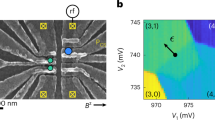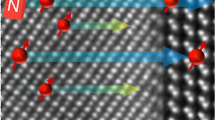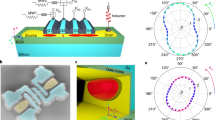Abstract
Spin-dependent electronic transport is widely used to probe and manipulate magnetic materials and develop spin-based devices. Spin-polarized tunnelling, successful in ferromagnetic metal junctions, was recently used to inject and detect electron spins in organics and bulk GaAs or Si. Electric field control of spin precession was studied in III–V semiconductors relying on spin–orbit interaction, which makes this approach inefficient for Si, the mainstream semiconductor. Methods to control spin other than through precession are thus desired. Here we demonstrate electrostatic modification of the magnitude of spin polarization in a silicon quantum well, and detection thereof by means of tunnelling to a ferromagnet, producing prominent oscillations of tunnel magnetoresistance of up to 8%. The electric modification of the spin polarization relies on discrete states in the Si with a Zeeman spin splitting, an approach that is also applicable to organic, carbon-based and other materials with weak spin–orbit interaction.
This is a preview of subscription content, access via your institution
Access options
Subscribe to this journal
Receive 12 print issues and online access
$259.00 per year
only $21.58 per issue
Buy this article
- Purchase on Springer Link
- Instant access to full article PDF
Prices may be subject to local taxes which are calculated during checkout






Similar content being viewed by others
References
Žutić, I., Fabian, J. & Das Sarma, S. Spintronics: Fundamentals and applications. Rev. Mod. Phys. 76, 323–410 (2004).
Awschalom, D. D. & Flatté, M. E. Challenges for semiconductor spintronics. Nature Phys. 3, 153–159 (2007).
Chappert, C., Fert, A. & Nguyen van Dau, F. The emergence of spin electronics in data storage. Nature Mater. 6, 813–823 (2007).
Moodera, J. S., Kinder, L. R., Wong, T. M. & Meservey, R. Large magnetoresistance at room temperature in ferromagnetic thin film tunnel junctions. Phys. Rev. Lett. 74, 3273–3276 (1995).
Miyazaki, T. & Tezuka, N. Giant magnetic tunnelling effect in Fe/Al2O3/Fe junction. J. Magn. Magn. Mater. 139, L231–L234 (1995).
Parkin, S. S. P. et al. Giant tunnelling magnetoresistance at room temperature with MgO (100) tunnel barriers. Nature Mater. 3, 862–867 (2004).
Yuasa, S., Nagahama, T., Fukushima, A., Suzuki, Y. & Ando, K. Giant room-temperature magnetoresistance in single-crystal Fe/MgO/Fe magnetic tunnel junctions. Nature Mater. 3, 868–871 (2004).
Fuchs, G. D. et al. Spin-transfer effects in nanoscale magnetic tunnel junctions. Appl. Phys. Lett. 85, 1205–1207 (2004).
Tulapurkar, A. A. et al. Spin-torque diode effect in magnetic tunnel junctions. Nature 438, 339–342 (2005).
Deac, A. M. et al. Bias-driven high-power microwave emission from MgO-based tunnel magnetoresistance devices. Nature Phys. 4, 803–809 (2008).
Appelbaum, I., Huang, B. & Monsma, D. J. Electronic measurement and control of spin transport in silicon. Nature 447, 295–298 (2007).
Hueso, L. E. et al. Transformation of spin information into large electrical signals using carbon nanotubes. Nature 445, 410–413 (2007).
Tombros, N., Jozsa, C., Popinciuc, M., Jonkman, H. T. & van Wees, B. J. Electronic spin transport and spin precession in single graphene layers at room temperature. Nature 448, 571–574 (2007).
Santos, T. S. et al. Room-temperature tunnel magnetoresistance and spin-polarized tunnelling through an organic semiconductor barrier. Phys. Rev. Lett. 98, 016601 (2007).
Lou, X. et al. Electrical detection of spin transport in lateral ferromagnet-semiconductor devices. Nature Phys. 3, 197–202 (2007).
Jonker, B. T., Kioseoglou, G., Hanbicki, A. T., Li, C. H. & Thompson, P. E. Electrical spin-injection into silicon from a ferromagnetic metal/tunnel barrier contact. Nature Phys. 3, 542–546 (2007).
van ’t Erve, O. M. J. et al. Electrical injection and detection of spin-polarized carriers in silicon in a lateral transport geometry. Appl. Phys. Lett. 91, 212109 (2007).
Dash, S. P., Sharma, S., Patel, R. S., de Jong, M. P. & Jansen, R. Electrical creation of spin polarization in silicon at room temperature. Nature 462, 491–494 (2009).
Min, B. C., Motohashi, K., Lodder, J. C. & Jansen, R. Tunable spin-tunnel contacts to silicon using low-work-function ferromagnets. Nature Mater. 5, 817–822 (2006).
Jansen, R. & Min, B. C. Detection of a spin accumulation in nondegenerate semiconductors. Phys. Rev. Lett. 99, 246604 (2007).
Žutić, I., Fabian, J. & Erwin, S. C. Spin injection and detection in silicon. Phys. Rev. Lett. 97, 026602 (2006).
Datta, S. & Das, B. Electronic analog of the electro-optic modulator. Appl. Phys. Lett. 56, 665–667 (1990).
Nitta, J., Akazaki, T., Takayanagi, H. & Enoki, T. Gate control of spin–orbit interaction in an inverted InGaAs/InAlAs heterostructure. Phys. Rev. Lett. 78, 1335–1338 (1997).
Salis, G. et al. Electrical control of spin coherence in semiconductor nanostructures. Nature 414, 619–622 (2001).
Sandhu, J. S., Heberle, A. P., Baumberg, J. J. & Cleaver, J. R. A. Gateable suppression of spin relaxation in semiconductors. Phys. Rev. Lett. 86, 2150–2153 (2001).
Karimov, O. Z. et al. High temperature gate control of quantum well spin memory. Phys. Rev. Lett. 91, 246601 (2003).
Hall, K. C. & Flatté, M. E. Performance of spin-based insulated gate field effect transistor. Appl. Phys. Lett. 88, 162503 (2006).
Koo, H. C. et al. Control of spin precession in a spin-injected field effect transistor. Science 325, 1515–1518 (2009).
Wilamowski, Z., Malissa, H., Schäffler, F. & Jantsch, W. g-factor tuning and manipulation of spins by an electric current. Phys. Rev. Lett. 98, 187203 (2007).
Ohno, H. et al. Electric field control of ferromagnetism. Nature 408, 944–946 (2000).
Lottermoser, Th. et al. Magnetic phase control by an electric field. Nature 430, 541–544 (2004).
Ando, T., Fowler, A. B. & Stern, F. Electronic properties of two-dimensional systems. Rev. Mod. Phys. 54, 437–672 (1982).
Biagi, R. et al. Photoemission investigation of alkali-metal-induced two-dimensional electron gas at the Si(111)(1×1):H surface. Phys. Rev. B 67, 155325 (2003).
Sze, S. M. Physics of Semiconductor Devices 2nd edn (Wiley, 1981).
Fert, A., George, J.-M., Jaffrès, H. & Mattana, R. Semiconductor between spin-polarized source and drain. IEEE Trans. Electron. Devices 54, 921–932 (2007).
Fert, A. & Jaffrès, H. Conditions for efficient spin injection from a ferromagnetic metal into a semiconductor. Phys. Rev. B 64, 184420 (2001).
Gould, C. et al. Tunneling anisotropic magnetoresistance: A spin-valve-like tunnel magnetoresistance using a single magnetic layer. Phys. Rev. Lett. 93, 117203 (2004).
Elsen, M. et al. Exchange-mediated anisotropy of (Ga, Mn)As valence-band probed by resonant tunnelling spectroscopy. Phys. Rev. Lett. 99, 127203 (2007).
Tsui, D. C. Electron-tunnelling studies of a quantized surface accumulation layer. Phys. Rev. B 4, 4438–4449 (1971).
Yuasa, S., Nagahama, T. & Suzuki, Y. Spin-polarized resonant tunnelling in magnetic tunnel junctions. Science 297, 234–237 (2002).
Shang, C. H., Nowak, J., Jansen, R. & Moodera, J. S. Temperature dependence of magnetoresistance and surface magnetization in ferromagnetic tunnel junctions. Phys. Rev. B 58, R2917–R2920 (1998).
Patel, R. S., Dash, S. P., de Jong, M. P. & Jansen, R. Magnetic tunnel contacts to silicon with low-work-function ytterbium nanolayers. J. Appl. Phys. 106, 016107 (2009).
Dery, H., Dalal, P., Cywiński, L. & Sham, L. J. Spin-based logic in semiconductors for reconfigurable large-scale circuits. Nature 447, 573–576 (2007).
Lampel, G. Nuclear dynamic polarization by optical electronic saturation and optical pumping in semiconductors. Phys. Rev. Lett. 20, 491–493 (1968).
Matsunami, J., Ooya, M. & Okamoto, T. Electrically detected electron spin resonance in a high-mobility silicon quantum well. Phys. Rev. Lett. 97, 066602 (2006).
Ohtomo, A. & Hwang, H. Y. A high-mobility electron gas at the LaAlO3/SrTiO3 heterointerface. Nature 427, 423–426 (2004).
Tsukazaki, A. et al. Quantum Hall effect in polar oxide heterostructures. Science 315, 1388–1391 (2007).
Novoselov, K. S. et al. Two-dimensional gas of massless Dirac fermions in graphene. Nature 438, 197–200 (2005).
Alves, H., Molinari, A. S., Xie, H. & Morpurgo, A. F. Metallic conduction at organic charge-transfer interfaces. Nature Mater. 7, 574–580 (2008).
Succi, M., Canino, R. & Ferrario, B. Atomic-absorption evaporation flow-rate measurements of alkali-metal dispensers. Vacuum 35, 579–582 (1985).
Acknowledgements
The authors are grateful to D. Pierce for sharing his knowledge about the Cs-metal dispensers, and to M. P. de Jong for useful discussions. This work was financially supported by the NWO-VIDI programme, the Netherlands Foundation for Fundamental Research on Matter (FOM) and the Netherlands Nanotechnology Networks NANOIMPULS and NANONED (supported by the Ministry of Economic Affairs).
Author information
Authors and Affiliations
Contributions
R.J. conceived and designed the experiment, coordinated the project and carried out most of the transport measurements. B.C.M. and S.P.D. fabricated the devices and carried out part of the measurements. All co-authors contributed important insight. R.J. wrote the paper, with input from all co-authors.
Corresponding author
Ethics declarations
Competing interests
The authors declare no competing financial interests.
Supplementary information
Supplementary Information
Supplementary Information (PDF 329 kb)
Rights and permissions
About this article
Cite this article
Jansen, R., Min, BC. & Dash, S. Oscillatory spin-polarized tunnelling from silicon quantum wells controlled by electric field. Nature Mater 9, 133–138 (2010). https://doi.org/10.1038/nmat2605
Received:
Accepted:
Published:
Issue Date:
DOI: https://doi.org/10.1038/nmat2605
This article is cited by
-
Gate-tunable large magnetoresistance in an all-semiconductor spin valve device
Nature Communications (2017)
-
Electrical gate control of spin current in van der Waals heterostructures at room temperature
Nature Communications (2017)
-
Spin transport and temperature-dependent giant positive junction magnetoresistance in CoFe2O4/SiO2/p-Si heterostructure
Applied Physics A (2016)
-
Direct-current voltages in (Ga,Mn)As structures induced by ferromagnetic resonance
Nature Communications (2013)
-
Efficient Spin Injection into Silicon and the Role of the Schottky Barrier
Scientific Reports (2013)



